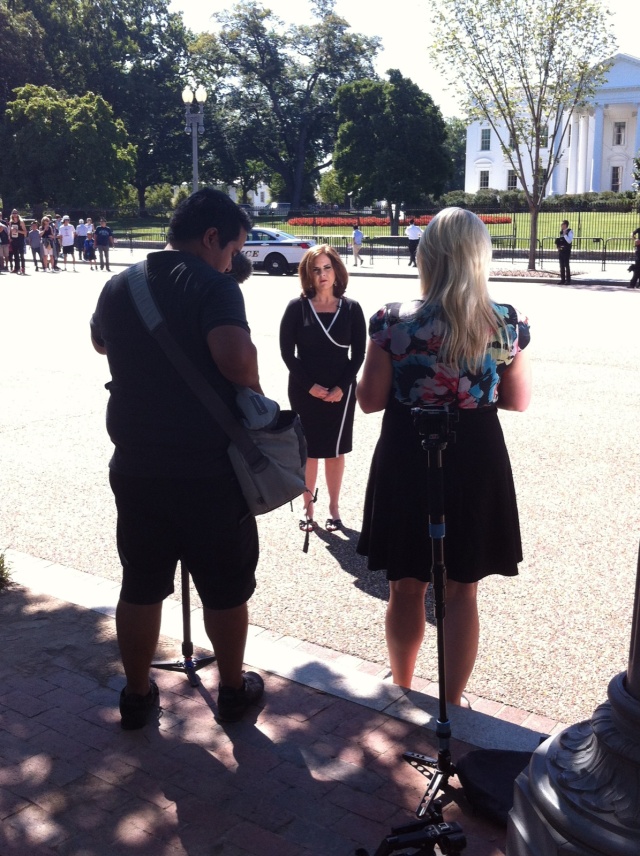To my family, friends and book and TV news fans:
One day in June 2015 I stood in my kitchen trying to cook about 3 o’clock in the afternoon. I had woken up with a severe migraine that morning, as I often did, but something was different. My face was tingling and I felt spacey, unable to remember things. Because I had spent most of the day in bed, I hadn’t eaten a whole lot. My husband and older boys were out of the house, at the library I think. My almost two-year-old son was napping.
While stirring eggs, shredded hash brown potatoes, sausage and cheese in a bowl, everything suddenly went black. As my knees buckled and I fell toward the floor, I woke up just as quickly as I had blacked out. My hands and arms caught my fall and fortunately I didn’t hit my head on the kitchen tile or nearby refrigerator.
Grabbing a water bottle and crawling in bed, I called my husband, who quickly returned home. The incident passed and I felt better soon.
I told two of my doctors about what happened. An earlier test had previously ruled out epilepsy. After consulting with some others about my case, one of my physicians put me on Lyrica, a nerve medicine that seemed to help some but my headaches continued to worsen.

Fast forward to the summer of 2016. In preparing for the launch of my new book, The Burning of the White House: James and Dolley Madison and the War of 1812, I knew I wasn’t feeling well and was worried about my physical stamina in meeting the demands of promoting my book, which I really wanted to do.
I want this nonfiction book (my ninth) to sell well, in part because I love this story about Dolley and James Madison. Both The Burning of the White House (Regnery History, Aug. 2016) and my book about John Quincy and Louisa Adams, American Phoenix (Thomas Nelson, 2013) will make great films and I have written award-winning screenplays for both.

To better manage my pain, I sought the help of a spine and pain doctor. In the midst of doing TV and radio interviews for my book, I found myself spending just as much time at a doctor’s office or at at an imaging center undergoing a variety of tests, several MRIs and CT scans of different parts of my body to try to figure out what was going on. By this point my headaches were 24/7 and I felt tingling all over my body.
A brain MRI revealed a condition called Chiari malformation, with Chiari pronounced as key-r-ee. Usually a birth defect, Chiari is often not detected until adulthood. This slow and insidious condition takes place when the tonsils of the brain – yes the brain has tonsils – slowly creep or intrude into the spinal cord. Occasionally significant trauma to the spinal cord can cause the herniation.
I visited three neurosurgeons, all with different opinions. The surgeon who listened most closely to my symptoms and thoroughly studied my brain MRI noticed that the shape of my brain tonsils was irritating my brain stem. He was also quite concerned when I told him about my near blackouts. Yes, I had a few more incidents but none were as scary to me as the one in June 2015.
As a result, I’m undergoing neurosurgery on Fri. Oct. 14, 2016. The surgeon will remove chips of bone from my skull to open up the space and insert a device to keep the space open.
I have to add, the hospital nurse in my pre-op interview scared me to death. I will be in ICU the first night. They will have to put an IV in one of my arteries, not just a vein, during surgery. Their biggest concern post-surgery is infection, especially an infection that is resistant to antibiotics. Because I tested positive for one of the colonies of concern, I have to go through a multi-day cleansing process before the surgery to minimize my infection chances.
The recovery at home will likely take between two and four weeks, but could last as long as eight weeks depending on how I do. Hopefully I will be back to normal by election day, which is important to the presidential historian side of my work, but for sure by Inauguration in January. Like it or not, this presidential election is historic no matter who wins.
My headaches began nine years ago and we thought they started because of a side effect from a medication I was taking for another condition. Though that was likely the case at the time, Chiari has been silently stalking me in the background. Over the years my headaches grew in frequency and intensity, despite my attempts to take preventive medicine and try a variety of treatments.
So chances are, if you’ve seen me on television on the Fox News Channel, C-SPAN, CBN and CNN, or heard me on the radio, I had a severe headache and was suffering greatly. You only have to look or act like you feel good for about three to 10 minutes when doing TV or radio.
 On my trip to New York to talk about my book with Brian Kilmeade on Fox and Friends and his radio show, Kilmeade and Friends, on Aug. 24, 2016, I had to lie down in between interviews because lying down is easier on my head than being upright. I ended up taking over two seats on the train to and from New York to D.C. so I could lie down. When I’m upright the headache floats to the top of my head like a hot air balloon unable to escape.
On my trip to New York to talk about my book with Brian Kilmeade on Fox and Friends and his radio show, Kilmeade and Friends, on Aug. 24, 2016, I had to lie down in between interviews because lying down is easier on my head than being upright. I ended up taking over two seats on the train to and from New York to D.C. so I could lie down. When I’m upright the headache floats to the top of my head like a hot air balloon unable to escape.
I can’t tell you how many times over the years different doctors have said to me, “I’ve never had a patient react like you do” to a medication or treatment or “you are so sensitive.” I’ve told one of my physicians several times that I am his petite Princess-and-the-Pea patient, because I am so highly sensitive. (One of my favorite TV shows is Once Upon a Time, Ginnifer Goodwin plays Snow White. In the final season of the TV show Rizzoli and Isles, one of the main characters, Maura Isles played by Sasha Alexander, battles Chiari)
You probably remember the Princess and the Pea fairytale by Hans Christian Andersen. The way to detect if a girl was a princess was to have her sleep on top of a stack of mattresses and place of pea in between two of the mattresses near the bottom of the stack. If she couldn’t sleep because of sensitivity, she was a true princess.
The Princess and the Pea is me. And in my case, the pea is called Chiari. (Key-r-ee)
But this Princess and the Pea hopes to awaken soon like Snow White, able to whistle while I work and sing a happy song again, fulfilling the purpose God has given me as a mom, wife, and writer.
In the Old Testament in the book of Joshua, God promised the people of Israel that He would be with them wherever they went and called on them to be strong and courageous. A friend of mine recently reminded me that God goes before us, is with with us through the trial and will be with us afterwards.
 So please pray for my surgery on Oct. 14, my husband, our three children and my dad. And pray for a smooth and quick recovery.
So please pray for my surgery on Oct. 14, my husband, our three children and my dad. And pray for a smooth and quick recovery.
I have thought about writing a book about all of this. My other books have mostly been about presidential history. This would be different, a memoir about the three health journeys I experienced through my years in the White House, then as an author, mother, and a frequent guest on the Fox News Channel the past eight years.
So stay tuned and thank you for your support.
And oh, if you want me to sign a bookplate for one of my books while I’m recovering, send an email with your mailing address to info@janecookcom. I can personalize, sign and mail you a book plate for free.
Love to all,
Jane Hampton Cook

